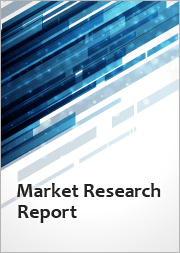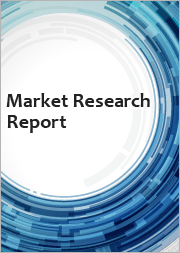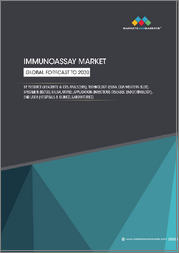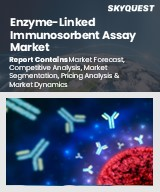
|
시장보고서
상품코드
1495997
세계의 효소결합면역흡착측정법(ELISA) 시장 - 예측(2024-2029년)Global Enzyme-Linked Immunosorbent Assay (ELISA) Market - Forecasts from 2024 to 2029 |
||||||
효소결합면역흡착측정법(ELISA) 시장은 연평균 5.56%의 CAGR로 성장하여 2022년 21억 3,800만 달러에서 2029년 31억 2,300만 달러로 증가할 것으로 예상됩니다.
ELISA(효소결합면역흡착측정법) 또는 효소면역분석법(EIA)은 펩타이드, 단백질, 항체, 호르몬과 같은 물질을 검출하고 정량화하기 위해 고안된 플레이트 기반 측정 기술입니다. ELISA의 반응 물질은 마이크로플레이트 표면에 고정되어 있어 분석 중에 결합 물질과 비결합 물질을 쉽게 분리할 수 있습니다. 따라서 조제물에서 특정 분석물질을 측정할 수 있는 강력한 도구가 될 수 있습니다.
ELISA의 일반적인 진단 용도로는 HIV 감염, 임신 검사, 단백질 검출 등이 있으며, ELISA 시장은 예측 기간 동안 견조한 성장세를 보일 것으로 예상됩니다. 이러한 성장의 배경에는 감염성 질환 및 만성 질환의 유병률 증가와 비용 효율적인 진단 도구로서 ELISA의 필요성이 대두되고 있기 때문으로 보입니다. 그러나 엄격한 규제 요건과 ELISA에 대한 불리한 상환 정책은 예측 기간 동안 시장 성장을 저해할 수 있습니다.
시장 촉진요인:
- 감염병의 증가는 시장 성장을 촉진할 것으로 예상됩니다.
시장 확대를 촉진하는 주요 요인 중 하나는 HIV, 간염, 말라리아, 뎅기열, 독감 등 전염병의 유병률 증가로 2021년 말 현재 전 세계 HIV 양성자가 3,840만 명으로 추정되며, 그 중 3분의 2 이상이 아프리카에 거주하고 있다고 WHO는 추정하고 있다, 뎅기열은 세계가 직면한 10대 건강 위협 중 하나라고 주장합니다. 지난 50 년 동안 전 세계적으로 뎅기열 발생이 약 3,000% 증가했으며, WHO는 2019년 현재 전 세계적으로 2억 9,600만 명 이상이 B 형 간염에 감염된 것으로 추정하고 있습니다.
감염성 질환의 발생이 증가함에 따라 진단에 대한 수요가 증가할 것으로 예상됩니다. 효소결합면역흡착검사와 같은 이러한 질병을 선별하기 위한 최첨단 진단 기술의 사용이 증가함에 따라 시장 확대가 예상됩니다.
또한, 전 세계적으로 질병 및 만성 질환에 걸릴 위험이 높고 일상적인 진단이 필요한 노인 인구의 증가는 시장 확대에 박차를 가할 것으로 예상되며, 2021년 미국 국립생물공학정보센터(NCBI)가 발표한 자료에 따르면 젊은 층에 비해 잠재적으로 위험한 질병은 노인 환자에서 발생할 가능성이 더 높습니다. 따라서 이러한 요인들은 효소결합면역흡착측정법에 대한 수요를 증가시켜 시장 성장을 크게 견인할 것으로 예상됩니다.
- 질병 진단 부문은 시장 성장률이 급증할 것으로 예상됩니다.
특정 항원 진단을 위한 효소결합면역흡착분석 검사의 사용이 확대됨에 따라 질병 진단 시장에서 상당한 점유율을 차지할 것으로 예상되며, WHO는 2022년 비감염성 질환으로 인해 매년 약 4,100만 명이 사망할 것으로 추정하고 있으며, 이는 전 세계 전체 사망자의 71%에 해당합니다. 이러한 질병의 발생으로 인해 사망자 발생을 최소화하기 위해 신속한 검출을 위한 ELISA와 같은 효율적인 진단 기술의 필요성이 증가하고 있습니다.
또한, Global Cancer Observatory에 따르면 2020년까지 전 세계적으로 약 1,930만 명이 새로 암에 걸리고 약 1,000만 명이 사망할 것으로 예상되며, ELISA는 항원을 평가하는 데 유용한 도구이기 때문에 전 세계 암 발병률의 증가로 인해 수요가 증가하고 있습니다.
2020년 Nature Scientific의 연구에 따르면, 효소결합면역흡착측정법은 유방암 항원과 전립선암 항원을 모두 찾아내는 데 사용할 수 있습니다. 이러한 정확한 항원 스크리닝과 비용 효율적인 진단은 ELISA 수요를 증가시키고 분석 기간 동안 시장 확대를 촉진할 것으로 예상됩니다.
북미 시장이 큰 시장 점유율을 차지할 것으로 예상
ELISA와 같은 스크리닝 기기의 기술 혁신의 빠른 시장 개척으로 인해 미국이 세계 시장을 독점할 가능성이 높습니다. 이 지역에서는 여러 감염성 질환과 만성 질환의 발생이 증가하고 있어 효소결합면역흡착측정법에 대한 수요가 증가하고 있습니다. 예를 들어, CDC(Centre for Ailment Control and Prevention)는 2022년 미국인의 60% 이상이 암, 심혈관계 질환, 뇌졸중 등 적어도 한 가지 이상의 만성질환을 앓고 있다고 보고했습니다.
Binder Dijker Otte USA Reports에 따르면, 2020년부터 바이오테크놀러지 지수 상장사들은 2020년까지 R&D 비용을 평균 약 16% 확대하여 2억 8,425만 달러에 달할 것으로 예상했습니다.
또한 2021년 미국 보건 복지부는 신속하고 고품질의 진단 테스트 생산능력을 높이기 위해 미국 구제 금융 계획에서 6억 5,000만 달러를 투입할 것이라고 발표했습니다. 따라서 예측 기간 동안 이러한 모든 측면이 북미 지역 시장을 충분히 지원할 것으로 예상됩니다.
주요 개발
- 2022년 9월 - Neogen Corporation은 강화된 정량적 ELISA 라인의 두 번째 제품인 캐슈넛 검출을 위한 Veratox VIP Assay를 발표했습니다. 이 혁신적인 검사는 샘플 유형에 관계없이 강력한 성능을 제공하며, Veratox 제품 라인의 단순한 검사 방법을 유지하며, Neogen은 전 세계 소비자를 보호하기 위해 가장 낮은 수준의 식품 알레르겐도 검출할 수 있는 고감도 검사를 제공하고자 합니다. 이 검사는 0.2ppm의 매우 낮은 수준의 캐슈 단백질에 대해 높은 특이성을 나타내며, Veratox VIP for Cashew는 기존 Veratox 제품군과 동일한 검사 방법을 사용하며, 30분 만에 결과를 얻을 수 있고, 즉시 사용 가능한 비위험물 시약도 포함되어 있습니다.
- 2022년 9월 - J Mitra는 4세대 ELISA 기반 HCV 검사 HCV Gen 4 Ag &Ab Microlisa를 발표했습니다. 이 체외 정성 ELISA는 인간 혈청 또는 혈장에서 HCV 핵심 항원 및 HCV에 대한 항체를 검출합니다. 이 검사는 만성 HCV 감염을 조기에 발견할 수 있도록 설계되었으며, 3세대 검사에 비해 급성 감염의 기간을 5-7주 단축할 수 있습니다. 이 검사는 고위험군 및 HIV/HCV 동시 감염 환자에게 특히 유용하며, ELISA 검사는 민감도와 특이도가 높고, 일괄 처리로 빠른 배송이 가능하며, J Mitra는 인도에서 HCV 진단을 개선하는 데 중요한 역할을 하고 있습니다.
목차
제1장 소개
- 시장 개요
- 시장 정의
- 조사 범위
- 시장 세분화
- 통화
- 가정
- 기준 연도와 예측 연도 타임라인
- 이해관계자에 대한 주요 이점
제2장 조사 방법
- 조사 디자인
- 조사 과정
제3장 주요 요약
- 주요 조사 결과
제4장 시장 역학
- 시장 성장 촉진요인
- 시장 성장 억제요인
- Porter's Five Forces 분석
- 업계 밸류체인 분석
- 애널리스트의 견해
제5장 효소결합면역흡착측정법(ELISA) 세계 시장 : 유형별
- 소개
- 간접 ELISA
- 샌드위치 ELISA
- 경쟁 ELISA
제6장 효소결합면역흡착측정법(ELISA) 세계 시장 : 용도별
- 소개
- 식품 및 음료
- 백신 개발
- 면역학
- 진단
- 약제 모니터링
- 기타
제7장 효소결합면역흡착측정법(ELISA) 세계 시장 : 최종사용자별
- 소개
- 제약 산업
- 병원과 클리닉
- 진단 센터
- 기타
제8장 효소결합면역흡착측정법(ELISA) 세계 시장 : 지역별
- 소개
- 북미
- 남미
- 유럽
- 중동 및 아프리카
- 아시아태평양
제9장 경쟁 환경과 분석
- 주요 기업과 전략 분석
- 시장 점유율 분석
- 합병, 인수, 합의와 협업
- 경쟁 대시보드
제10장 기업 개요
- Pestka Biomedical Laboratories, Inc.
- Diaclone SAS
- Thermo Fisher Scientific Inc.
- Azure Biosystems Inc.
- R&D Systems, Inc
- RayBiotech, Inc.
- Elabscience
- BioLegend, Inc.
- Randox Toxicology
- STEMCELL Technologies Inc.
- Genway Biotech, Inc.
The global Enzyme-Linked Immunosorbent Assay (ELISA) market is projected to grow at a CAGR of 5.56% increasing from US$2.138 billion in 2022 to US$3.123 billion in 2029.
ELISA (enzyme-linked immunosorbent assay) or enzyme immunoassay (EIA) is a plate-based assay technique designed for detecting and quantifying substances such as peptides, proteins, antibodies, and hormones. ELISA is often used as a screening tool before further in-depth tests are ordered. Reactants of the ELISA are immobilized to the microplate surface, making it easy to separate bound from non-bound material during the assay. This makes it a powerful tool for measuring specific analytes within a crude preparation.
The common diagnostic applications of ELISA are HIV infection, pregnancy tests, detection of proteins, etc. The ELISA market is expected to show robust growth during the forecast period. The growth may be attributed to the rising incidence of infectious and chronic diseases, which require ELISA as a cost-effective diagnostic tool. However, stringent regulatory requirements, as well as unfavorable reimbursement policies about ELISA, might hamper the market growth during the given time frame.
Market Drivers:
- The rising prevalence of infectious diseases is predicted to propel the market growth.
One of the key drivers fuelling the market's expansion is the rising prevalence of infectious diseases like HIV, Hepatitis, malaria, dengue, and influenza, among other ailments. At the end of 2021, the WHO estimated that there were 38.4 million HIV-positive individuals worldwide, with more than two-thirds of them living in Africa. The WHO also claimed that dengue fever was among the top ten health threats facing the world. Over the past 50 years, dengue incidences have increased by about 3000% worldwide. WHO also estimated that more than 296 million individuals worldwide have hepatitis B infection as of 2019.
The demand for diagnosis is anticipated to rise as a result of the rising occurrence of infectious diseases. The market is anticipated to expand due to the rising use of cutting-edge diagnostic techniques for screening these disorders, such as enzyme-linked immunosorbent tests.
Additionally, the growing geriatric population, which is globally at risk of contracting illnesses and chronic diseases and requires routine diagnosis, is anticipated to fuel market expansion. In comparison to younger individuals, potentially dangerous illnesses are more likely in elderly patients, according to the NCBI (National Center for Biotechnology Information), which published this information in 2021. Thus, it is anticipated that these factors will considerably raise the market's growth by boosting demand for enzyme-linked immunosorbent assays.
- The disease diagnosis segment is anticipated to surge the market growth.
Due to the growing use of enzyme-linked immunosorbent assay tests for the diagnosis of specific antigens, a sizable share of the disease diagnosis market has been predicted. In 2022, the WHO estimated that non-communicable illnesses caused around 41 million deaths each year, equivalent to 71% of all deaths worldwide. Due to these occurrences, there is now a greater need for efficient diagnostic techniques like ELISA for prompt detection to minimize death occurrences.
Additionally, according to the Global Cancer Observatory, there were approximately 19.3 million new cases of cancer and nearly 10.0 million cancer deaths worldwide in 2020. As ELISA is a useful instrument for assessing antigens, the rise in cancer incidence around the world is driving up demand for it.
The Enzyme-Linked Immunosorbent Assay can be used to find both breast cancer antigens and prostate cancer antigens, according to a 2020 Nature Scientific study. Such accurate antigen screening and cost-effective diagnosis are anticipated to boost ELISA demand and drive the market's expansion during the analyzed period.
North America is Expected to Hold a Significant Share in the Market
Because of the rapid development of technological breakthroughs in screening instruments like ELISA, the US is likely to dominate the global market. The increasing incidences of multiple infectious and chronic diseases in this demography are contributing to the strong demand for Enzyme-Linked Immunosorbent Assay. For instance, the CDC (Centre for Ailment Control and Prevention) reported in 2022 that over 60% of Americans had at least one chronic disease, such as cancer, cardiovascular disease, or stroke.
The market in this region is anticipated to grow as a result of rising R&D expenditures as well as numerous funding initiatives for diagnostics. Listed firms on the biotechnology index expanded their R&D spending by about 16% on average in 2020 to USD 284.25 million in the US, based on the Binder Dijker Otte USA Reports from 2020.
Additionally, in 2021, the Department of Health and Human Services said that it would deploy USD 650 million from the American rescue plan to increase production capabilities for swift, high-quality diagnostic tests. Therefore, it is projected that all of these aspects will support the North American regional market well over the predicted period.
Key Developments:
- September 2022- Neogen Corporation introduced its Veratox VIP assay for cashew detection, the second in its enhanced quantitative ELISA line. This innovative test offers robust performance across sample types and maintains the simple testing methodology of the Veratox product line. Neogen aims to offer highly sensitive tests that can detect even the lowest levels of food allergens, protecting consumers worldwide. The test demonstrates a high level of specificity to very low levels of cashew protein, down to 0.2 ppm. The Veratox VIP for Cashew uses the same testing methodology as its existing Veratox product line, including a 30-minute time-to-result and ready-to-use, non-hazardous reagents.
- September 2022- J Mitra introduced the HCV Gen 4 Ag & Ab Microlisa, a 4th Generation Elisa-based HCV test. This in-vitro qualitative ELISA detects HCV core antigens and antibodies against HCV in human serum or plasma. The test is designed to help detect chronic HCV infections early, reducing the window period for acute infection by 5-7 weeks compared to the 3rd generation test. The test is particularly useful in high-risk groups and HIV/HCV co-infected patients. The Elisa test offers higher sensitivity and specificity, and batch processing can result in a quick turnaround time. J Mitra has played a significant role in improving HCV diagnosis in India.
Segmentation:
By Type
- Indirect ELISA
- Sandwich ELISA
- Competitive ELISA
By Application
- Food and Beverage
- Vaccine Development
- Immunology
- Diagnosis
- Drug Monitoring
- Others
By End Users
- Pharmaceutical Industries
- Hospitals and Clinics
- Diagnostic Centres
- Others
By Geography
- North America
- United States
- Canada
- Mexico
- South America
- Brazil
- Argentina
- Others
- Europe
- UK
- Germany
- France
- Italy
- Spain
- Others
- Middle East and Africa (MEA)
- Saudi Arabia
- UAE
- Israel
- Others
- Asia Pacific
- Japan
- China
- India
- Australia
- South Korea
- Indonesia
- Thailand
- Taiwan
- Others
TABLE OF CONTENTS
1. INTRODUCTION
- 1.1. Market Overview
- 1.2. Market Definition
- 1.3. Scope of the Study
- 1.4. Market Segmentation
- 1.5. Currency
- 1.6. Assumptions
- 1.7. Base and Forecast Years Timeline
- 1.8. Key Benefits to the Stakeholder
2. RESEARCH METHODOLOGY
- 2.1. Research Design
- 2.2. Research Processes
3. EXECUTIVE SUMMARY
- 3.1. Key Findings
4. MARKET DYNAMICS
- 4.1. Market Drivers
- 4.2. Market Restraints
- 4.3. Porter's Five Forces Analysis
- 4.3.1. Bargaining Power of Suppliers
- 4.3.2. Bargaining Power of Buyers
- 4.3.3. Threat of New Entrants
- 4.3.4. Threat of Substitutes
- 4.3.5. Competitive Rivalry in the Industry
- 4.4. Industry Value Chain Analysis
- 4.5. Analyst View
5. GLOBAL ENZYME-LINKED IMMUNOSORBENT ASSAY (ELISA) MARKET BY TYPE
- 5.1. Introduction
- 5.2. Indirect ELISA
- 5.2.1. Market Opportunities and Trends
- 5.2.2. Growth Prospects
- 5.2.3. Geographic Lucrativeness
- 5.3. Sandwich ELISA
- 5.3.1. Market Opportunities and Trends
- 5.3.2. Growth Prospects
- 5.3.3. Geographic Lucrativeness
- 5.4. Competitive ELISA
- 5.4.1. Market Opportunities and Trends
- 5.4.2. Growth Prospects
- 5.4.3. Geographic Lucrativeness
6. GLOBAL ENZYME-LINKED IMMUNOSORBENT ASSAY (ELISA) MARKET BY APPLICATION
- 6.1. Introduction
- 6.2. Food and Beverage
- 6.2.1. Market Opportunities and Trends
- 6.2.2. Growth Prospects
- 6.2.3. Geographic Lucrativeness
- 6.3. Vaccine Development
- 6.3.1. Market Opportunities and Trends
- 6.3.2. Growth Prospects
- 6.3.3. Geographic Lucrativeness
- 6.4. Immunology
- 6.4.1. Market Opportunities and Trends
- 6.4.2. Growth Prospects
- 6.4.3. Geographic Lucrativeness
- 6.5. Diagnosis
- 6.5.1. Market Opportunities and Trends
- 6.5.2. Growth Prospects
- 6.5.3. Geographic Lucrativeness
- 6.6. Drug Monitoring
- 6.6.1. Market Opportunities and Trends
- 6.6.2. Growth Prospects
- 6.6.3. Geographic Lucrativeness
- 6.7. Others
- 6.7.1. Market Opportunities and Trends
- 6.7.2. Growth Prospects
- 6.7.3. Geographic Lucrativeness
7. GLOBAL ENZYME-LINKED IMMUNOSORBENT ASSAY (ELISA) MARKET BY END USERS
- 7.1. Introduction
- 7.2. Pharmaceutical Industries
- 7.2.1. Market Opportunities and Trends
- 7.2.2. Growth Prospects
- 7.2.3. Geographic Lucrativeness
- 7.3. Hospitals and Clinics
- 7.3.1. Market Opportunities and Trends
- 7.3.2. Growth Prospects
- 7.3.3. Geographic Lucrativeness
- 7.4. Diagnostic Centres
- 7.4.1. Market Opportunities and Trends
- 7.4.2. Growth Prospects
- 7.4.3. Geographic Lucrativeness
- 7.5. Others
- 7.5.1. Market Opportunities and Trends
- 7.5.2. Growth Prospects
- 7.5.3. Geographic Lucrativeness
8. GLOBAL ENZYME-LINKED IMMUNOSORBENT ASSAY (ELISA) MARKET BY GEOGRAPHY
- 8.1. Introduction
- 8.2. North America
- 8.2.1. By Type
- 8.2.2. By Application
- 8.2.3. By End Users
- 8.2.4. By Country
- 8.2.4.1. United States
- 8.2.4.1.1. Market Opportunities and Trends
- 8.2.4.1.2. Growth Prospects
- 8.2.4.2. Canada
- 8.2.4.2.1. Market Opportunities and Trends
- 8.2.4.2.2. Growth Prospects
- 8.2.4.3. Mexico
- 8.2.4.3.1. Market Opportunities and Trends
- 8.2.4.3.2. Growth Prospects
- 8.2.4.1. United States
- 8.3. South America
- 8.3.1. By Type
- 8.3.2. By Application
- 8.3.3. By End Users
- 8.3.4. By Country
- 8.3.4.1. Brazil
- 8.3.4.1.1. Market Opportunities and Trends
- 8.3.4.1.2. Growth Prospects
- 8.3.4.2. Argentina
- 8.3.4.2.1. Market Opportunities and Trends
- 8.3.4.2.2. Growth Prospects
- 8.3.4.3. Others
- 8.3.4.3.1. Market Opportunities and Trends
- 8.3.4.3.2. Growth Prospects
- 8.3.4.1. Brazil
- 8.4. Europe
- 8.4.1. By Type
- 8.4.2. By Application
- 8.4.3. By End Users
- 8.4.4. By Country
- 8.4.4.1. UK
- 8.4.4.1.1. Market Opportunities and Trends
- 8.4.4.1.2. Growth Prospects
- 8.4.4.2. Germany
- 8.4.4.2.1. Market Opportunities and Trends
- 8.4.4.2.2. Growth Prospects
- 8.4.4.3. France
- 8.4.4.3.1. Market Opportunities and Trends
- 8.4.4.3.2. Growth Prospects
- 8.4.4.4. Italy
- 8.4.4.4.1. Market Opportunities and Trends
- 8.4.4.4.2. Growth Prospects
- 8.4.4.5. Spain
- 8.4.4.5.1. Market Opportunities and Trends
- 8.4.4.5.2. Growth Prospects
- 8.4.4.6. Others
- 8.4.4.6.1. Market Opportunities and Trends
- 8.4.4.6.2. Growth Prospects
- 8.4.4.1. UK
- 8.5. Middle East and Africa
- 8.5.1. By Type
- 8.5.2. By Application
- 8.5.3. By End Users
- 8.5.4. By Country
- 8.5.4.1. Saudi Arabia
- 8.5.4.1.1. Market Opportunities and Trends
- 8.5.4.1.2. Growth Prospects
- 8.5.4.2. UAE
- 8.5.4.2.1. Market Opportunities and Trends
- 8.5.4.2.2. Growth Prospects
- 8.5.4.3. Israel
- 8.5.4.3.1. Market Opportunities and Trends
- 8.5.4.3.2. Growth Prospects
- 8.5.4.4. Others
- 8.5.4.4.1. Market Opportunities and Trends
- 8.5.4.4.2. Growth Prospects
- 8.5.4.1. Saudi Arabia
- 8.6. Asia Pacific
- 8.6.1. By Type
- 8.6.2. By Application
- 8.6.3. By End Users
- 8.6.4. By Country
- 8.6.4.1. Japan
- 8.6.4.1.1. Market Opportunities and Trends
- 8.6.4.1.2. Growth Prospects
- 8.6.4.2. China
- 8.6.4.2.1. Market Opportunities and Trends
- 8.6.4.2.2. Growth Prospects
- 8.6.4.3. India
- 8.6.4.3.1. Market Opportunities and Trends
- 8.6.4.3.2. Growth Prospects
- 8.6.4.4. Australia
- 8.6.4.4.1. Market Opportunities and Trends
- 8.6.4.4.2. Growth Prospects
- 8.6.4.5. South Korea
- 8.6.4.5.1. Market Opportunities and Trends
- 8.6.4.5.2. Growth Prospects
- 8.6.4.6. Indonesia
- 8.6.4.6.1. Market Opportunities and Trends
- 8.6.4.6.2. Growth Prospects
- 8.6.4.7. Thailand
- 8.6.4.7.1. Market Opportunities and Trends
- 8.6.4.7.2. Growth Prospects
- 8.6.4.8. Taiwan
- 8.6.4.8.1. Market Opportunities and Trends
- 8.6.4.8.2. Growth Prospects
- 8.6.4.9. Others
- 8.6.4.9.1. Market Opportunities and Trends
- 8.6.4.9.2. Growth Prospects
- 8.6.4.1. Japan
9. COMPETITIVE ENVIRONMENT AND ANALYSIS
- 9.1. Major Players and Strategy Analysis
- 9.2. Market Share Analysis
- 9.3. Mergers, Acquisitions, Agreements, and Collaborations
- 9.4. Competitive Dashboard
10. COMPANY PROFILES
- 10.1. Pestka Biomedical Laboratories, Inc.
- 10.2. Diaclone SAS
- 10.3. Thermo Fisher Scientific Inc.
- 10.4. Azure Biosystems Inc.
- 10.5. R&D Systems, Inc
- 10.6. RayBiotech, Inc.
- 10.7. Elabscience
- 10.8. BioLegend, Inc.
- 10.9. Randox Toxicology
- 10.10. STEMCELL Technologies Inc.
- 10.11. Genway Biotech, Inc.



















